Controlled Crystallinity of a Sn-Doped α-Ga2O3 Epilayer Using Rapidly Annealed Double Buffer Layers
Abstract
1. Introduction
2. Materials and Methods
3. Results
3.1. Growth of (AlxGa1−x)2O3/Ga2O3 Buffer Layers and Rapid Thermal Annealing
3.2. Growth of the Sn-Doped α-Ga2O3 Thin Film on the Double Buffer Layers
3.3. Electrical Properties of the Grown Sn-Doped Ga2O3 Layers
4. Conclusions
Author Contributions
Funding
Data Availability Statement
Conflicts of Interest
References
- Pearton, S.J.; Yang, J.; Cary, P.H., IV; Ren, F.; Kim, J.; Tadjer, M.J.; Mastro, M.A. A Review of Ga2O3 Materials, Processing, and Devices. Appl. Phys. Rev. 2018, 5, 011301. [Google Scholar] [CrossRef]
- Shenai, K. Future Prospects of Widebandgap (WBG) Semiconductor Power Switching Devices. IEEE Trans. Electron Devices 2015, 62, 248–257. [Google Scholar] [CrossRef]
- Tsao, J.Y.; Chowdhury, S.; Hollis, M.A.; Jena, D.; Johnson, N.M.; Jones, K.A.; Kaplar, R.J.; Rajan, S.; Van de Walle, C.G.; Bellotti, E.; et al. Ultrawide-Bandgap Semiconductors: Research Opportunities and Challenges. Adv. Electron. Mater. 2018, 4, 1600501. [Google Scholar] [CrossRef]
- Ro, H.-S.; Kang, S.H.; Jung, S. The Effect of Gate Work Function and Electrode Gap on Wide Band-Gap Sn-Doped α-Ga2O3 Metal–Semiconductor Field-Effect Transistors. Materials 2022, 15, 913. [Google Scholar] [CrossRef] [PubMed]
- Zhang, D.; Yu, H.; You, G.; Shao, G.; Fang, Z.; Liang, Z.; Zhang, T.; Hou, H.; Wang, L.; Chen, Q.; et al. Ambient-Condition Strategy for Rapid Mass Production of Crystalline Gallium Oxide Nanoarchitectures toward Device Application. J. Mater. Sci. Technol. 2023, 163, 150–157. [Google Scholar] [CrossRef]
- Sheng, T.; Liu, X.-Z.; Qian, L.-X.; Xu, B.; Zhang, Y.-Y. Photoelectric Properties of β-Ga2O3 Thin Films Annealed at Different Conditions. Rare Met. 2022, 41, 1375–1379. [Google Scholar] [CrossRef]
- Roy, R.; Hill, V.G.; Osborn, E.F. Polymorphism of Ga2O3 and the System Ga2O3–H2O. J. Am. Chem. Soc. 1952, 74, 719–722. [Google Scholar] [CrossRef]
- Mohamed, H.F.; Xia, C.; Sai, Q.; Cui, H.; Pan, M.; Qi, H. Growth and Fundamentals of Bulk β-Ga2O3 Single Crystals. J. Semicond. 2019, 40, 011801. [Google Scholar] [CrossRef]
- Bae, S.-Y. Growth of Various Phases of Gallium Oxide. In Digital Encyclopedia of Applied Physics; John Wiley & Sons, Ltd.: Hoboken, NJ, USA, 2021; pp. 1–37. ISBN 978-3-527-60043-4. [Google Scholar]
- Mastro, M.A.; Kuramata, A.; Calkins, J.; Kim, J.; Ren, F.; Pearton, S.J. Perspective—Opportunities and Future Directions for Ga2O3. ECS J. Solid State Sci. Technol. 2017, 6, P356–P359. [Google Scholar] [CrossRef]
- Fujita, S.; Oda, M.; Kaneko, K.; Hitora, T. Evolution of Corundum-Structured III-Oxide Semiconductors: Growth, Properties, and Devices. Jpn. J. Appl. Phys. 2016, 55, 1202A3. [Google Scholar] [CrossRef]
- Shinohara, D.; Fujita, S. Heteroepitaxy of Corundum-Structured α-Ga2O3 Thin Films on α-Al2O3 Substrates by Ultrasonic Mist Chemical Vapor Deposition. Jpn. J. Appl. Phys. 2008, 47, 7311. [Google Scholar] [CrossRef]
- Fujita, S.; Kaneko, K. Epitaxial Growth of Corundum-Structured Wide Band Gap III-Oxide Semiconductor Thin Films. J. Cryst. Growth 2014, 401, 588–592. [Google Scholar] [CrossRef]
- Lee, S.-D.; Ito, Y.; Kaneko, K.; Fujita, S. Enhanced Thermal Stability of Alpha Gallium Oxide Films Supported by Aluminum Doping. Jpn. J. Appl. Phys. 2015, 54, 030301. [Google Scholar] [CrossRef]
- Jinno, R.; Uchida, T.; Kaneko, K.; Fujita, S. Control of Crystal Structure of Ga2O3 on Sapphire Substrate by Introduction of α-(AlxGa1−x)2O3 Buffer Layer. Phys. Status Solidi 2018, 255, 1700326. [Google Scholar] [CrossRef]
- Kim, K.-H.; Shin, Y.-J.; Jeong, S.-M.; Bae, S.-Y. Bandgap Control of (AlxGa1−x)2O3 Epilayers by Controlling Aqueous Precursor Mixing Ratio in Mist Chemical Vapor Deposition System. J. Korean Inst. Electr. Electron. Mater. Eng. 2019, 32, 528–533. [Google Scholar] [CrossRef]
- Suzuki, N.; Kaneko, K.; Fujita, S. Growth of Corundum-Structured (InxGa1−x)2O3 Alloy Thin Films on Sapphire Substrates with Buffer Layers. J. Cryst. Growth 2014, 401, 670–672. [Google Scholar] [CrossRef]
- Kawaharamura, T.; Dang, G.T.; Furuta, M. Successful Growth of Conductive Highly Crystalline Sn-Doped α-Ga2O3 Thin Films by Fine-Channel Mist Chemical Vapor Deposition. Jpn. J. Appl. Phys. 2012, 51, 040207. [Google Scholar] [CrossRef]
- Kim, K.-H.; Ha, M.-T.; Lee, H.; Kim, M.; Nam, O.; Shin, Y.-J.; Jeong, S.-M.; Bae, S.-Y. Microstructural Gradational Properties of Sn-Doped Gallium Oxide Heteroepitaxial Layers Grown Using Mist Chemical Vapor Deposition. Materials 2022, 15, 1050. [Google Scholar] [CrossRef]
- Uchida, T.; Kaneko, K.; Fujita, S. Electrical Characterization of Si-Doped n-Type α-Ga2O3 on Sapphire Substrates. MRS Adv. 2018, 3, 171–177. [Google Scholar] [CrossRef]
- Ahmadi, E.; Koksaldi, O.S.; Kaun, S.W.; Oshima, Y.; Short, D.B.; Mishra, U.K.; Speck, J.S. Ge Doping of β-Ga2O3 Films Grown by Plasma-Assisted Molecular Beam Epitaxy. Appl. Phys. Express 2017, 10, 041102. [Google Scholar] [CrossRef]
- Orita, M.; Ohta, H.; Hirano, M.; Hosono, H. Deep-Ultraviolet Transparent Conductive β-Ga2O3 Thin Films. Appl. Phys. Lett. 2000, 77, 4166–4168. [Google Scholar] [CrossRef]
- Sasaki, K.; Kuramata, A.; Masui, T.; Víllora, E.G.; Shimamura, K.; Yamakoshi, S. Device-Quality β-Ga2O3 Epitaxial Films Fabricated by Ozone Molecular Beam Epitaxy. Appl. Phys. Express 2012, 5, 035502. [Google Scholar] [CrossRef]
- Akaiwa, K.; Kaneko, K.; Ichino, K.; Fujita, S. Conductivity Control of Sn-Doped α-Ga2O3 Thin Films Grown on Sapphire Substrates. Jpn. J. Appl. Phys. 2016, 55, 1202BA. [Google Scholar] [CrossRef]
- Oshima, Y.; Kawara, K.; Shinohe, T.; Hitora, T.; Kasu, M.; Fujita, S. Epitaxial Lateral Overgrowth of α-Ga2O3 by Halide Vapor Phase Epitaxy. APL Mater. 2018, 7, 022503. [Google Scholar] [CrossRef]
- Oshima, Y.; Kawara, K.; Oshima, T.; Okigawa, M.; Shinohe, T. Phase-Controlled Epitaxial Lateral Overgrowth of α-Ga2O3 by Halide Vapor Phase Epitaxy. Jpn. J. Appl. Phys. 2020, 59, 025512. [Google Scholar] [CrossRef]
- Son, H.; Choi, Y.; Ha, J.-S.; Jung, S.H.; Jeon, D.-W. Crystal Quality Improvement of α-Ga2O3 Growth on Stripe Patterned Template via Epitaxial Lateral Overgrowth. Cryst. Growth Des. 2019, 19, 5105–5110. [Google Scholar] [CrossRef]
- Dang, G.T.; Sato, S.; Tagashira, Y.; Yasuoka, T.; Liu, L.; Kawaharamura, T. α-(AlxGa1−x)2O3 Single-Layer and Heterostructure Buffers for the Growth of Conductive Sn-Doped α-Ga2O3 Thin Films via Mist Chemical Vapor Deposition. APL Mater. 2020, 8, 101101. [Google Scholar] [CrossRef]
- Jinno, R.; Uchida, T.; Kaneko, K.; Fujita, S. Reduction in Edge Dislocation Density in Corundum-Structured α-Ga2O3 Layers on Sapphire Substrates with Quasi-Graded α-(Al,Ga)2O3 Buffer Layers. Appl. Phys. Express 2016, 9, 071101. [Google Scholar] [CrossRef]
- Yao, Y.; Okur, S.; Lyle, L.A.M.; Tompa, G.S.; Salagaj, T.; Sbrockey, N.; Davis, R.F.; Porter, L.M. Growth and Characterization of α-, β-, and ϵ-Phases of Ga2O3 Using MOCVD and HVPE Techniques. Mater. Res. Lett. 2018, 6, 268–275. [Google Scholar] [CrossRef]
- Zhang, F.B.; Saito, K.; Tanaka, T.; Nishio, M.; Guo, Q.X. Structural and Optical Properties of Ga2O3 Films on Sapphire Substrates by Pulsed Laser Deposition. J. Cryst. Growth 2014, 387, 96–100. [Google Scholar] [CrossRef]
- Oshima, T.; Okuno, T.; Fujita, S. Ga2O3 Thin Film Growth on C-Plane Sapphire Substrates by Molecular Beam Epitaxy for Deep-Ultraviolet Photodetectors. Jpn. J. Appl. Phys. 2007, 46, 7217. [Google Scholar] [CrossRef]
- Venables, J.A. (Ed.) Surface Processes in Epitaxial Growth. In Introduction to Surface and Thin Film Processes; Cambridge University Press: Cambridge, UK, 2000; pp. 144–183. ISBN 978-0-521-78500-6. [Google Scholar]
- Oura, K.; Katayama, M.; Zotov, A.V.; Lifshits, V.G.; Saranin, A.A. Growth of Thin Films. In Surface Science: An Introduction; Oura, K., Katayama, M., Zotov, A.V., Lifshits, V.G., Saranin, A.A., Eds.; Advanced Texts in Physics; Springer: Berlin/Heidelberg, Germany, 2003; pp. 357–387. ISBN 978-3-662-05179-5. [Google Scholar]
- Brune, H. Epitaxial Growth of Thin Films. In Surface and Interface Science; John Wiley & Sons, Ltd.: Hoboken, NJ, USA, 2013; pp. 421–492. ISBN 978-3-527-68056-6. [Google Scholar]
- Ma, T.; Chen, X.; Ren, F.; Zhu, S.; Gu, S.; Zhang, R.; Zheng, Y.; Ye, J. Heteroepitaxial Growth of Thick α-Ga2O3 Film on Sapphire (0001) by MIST-CVD Technique. J. Semicond. 2019, 40, 012804. [Google Scholar] [CrossRef]
- Ha, M.-T.; Kim, K.-H.; Shin, Y.-J.; Jeong, S.-M.; Bae, S.-Y. Leidenfrost Motion of Water Microdroplets on Surface Substrate: Epitaxy of Gallium Oxide via Mist Chemical Vapor Deposition. Adv. Mater. Interfaces 2021, 8, 2001895. [Google Scholar] [CrossRef]
- Denton, A.R.; Ashcroft, N.W. Vegard’s Law. Phys. Rev. A 1991, 43, 3161–3164. [Google Scholar] [CrossRef] [PubMed]
- Roberts, J.W.; Chalker, P.R.; Ding, B.; Oliver, R.A.; Gibbon, J.T.; Jones, L.A.H.; Dhanak, V.R.; Phillips, L.J.; Major, J.D.; Massabuau, F.C.-P. Low Temperature Growth and Optical Properties of α-Ga2O3 Deposited on Sapphire by Plasma Enhanced Atomic Layer Deposition. J. Cryst. Growth 2019, 528, 125254. [Google Scholar] [CrossRef]
- Playford, H.Y.; Hannon, A.C.; Barney, E.R.; Walton, R.I. Structures of Uncharacterised Polymorphs of Gallium Oxide from Total Neutron Diffraction. Chem. Eur. J. 2013, 19, 2803–2813. [Google Scholar] [CrossRef] [PubMed]
- Jinno, R.; Kaneko, K.; Fujita, S. Thermal Stability of α-Ga2O3 Films Grown on c-Plane Sapphire Substrates via Mist-CVD. AIP Adv. 2020, 10, 115013. [Google Scholar] [CrossRef]
- Tauc, J. Optical Properties and Electronic Structure of Amorphous Ge and Si. Mater. Res. Bull. 1968, 3, 37–46. [Google Scholar] [CrossRef]
- Kaneko, K.; Kawanowa, H.; Ito, H.; Fujita, S. Evaluation of Misfit Relaxation in α-Ga2O3 Epitaxial Growth on α-Al2O3 Substrate. Jpn. J. Appl. Phys. 2012, 51, 020201. [Google Scholar] [CrossRef]
- Xu, Y.; Park, J.-H.; Yao, Z.; Wolverton, C.; Razeghi, M.; Wu, J.; Dravid, V.P. Strain-Induced Metastable Phase Stabilization in Ga2O3 Thin Films. ACS Appl. Mater. Interfaces 2019, 11, 5536–5543. [Google Scholar] [CrossRef]
- Ng, H.M.; Doppalapudi, D.; Moustakas, T.D.; Weimann, N.G.; Eastman, L.F. The Role of Dislocation Scattering in N-Type GaN Films. Appl. Phys. Lett. 1998, 73, 821–823. [Google Scholar] [CrossRef]
- Shin, H.; Lim, K.; Hwang, S.; Han, I.-K.; Jang, M. The Evaluation of Hole Mobility Characteristics with Surface Roughness. J. Nanosci. Nanotechnol. 2017, 17, 7766–7770. [Google Scholar] [CrossRef]
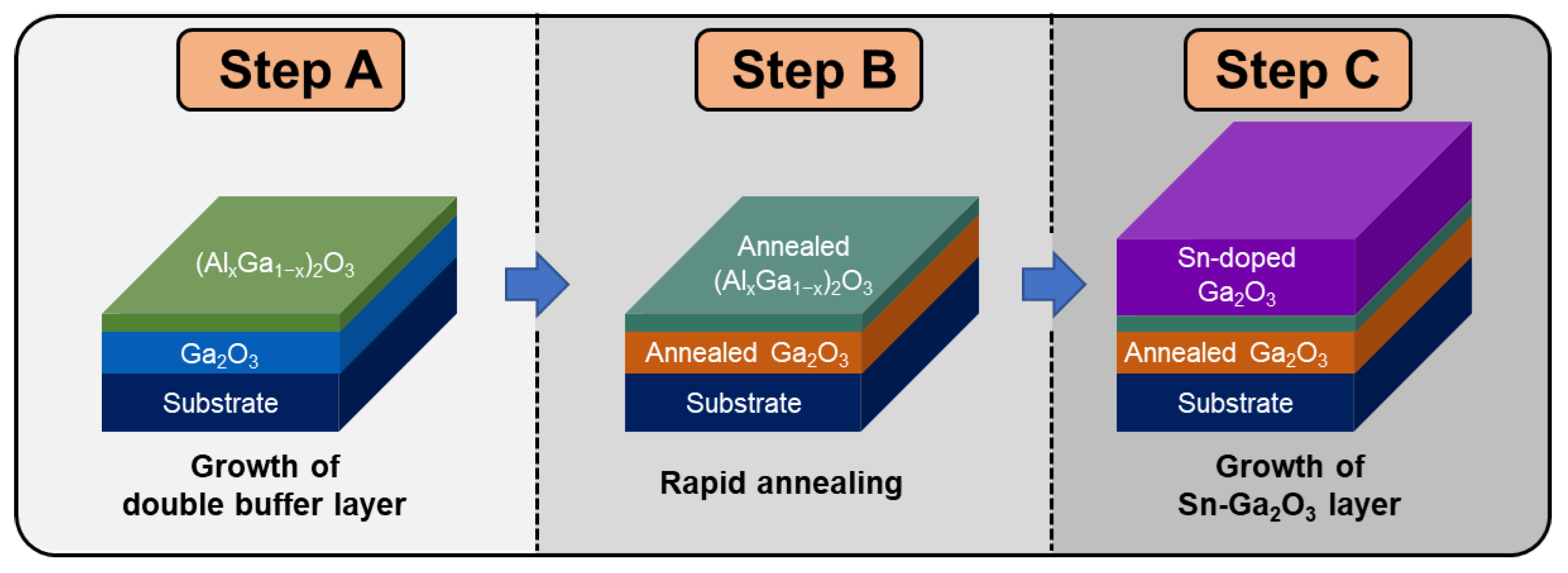
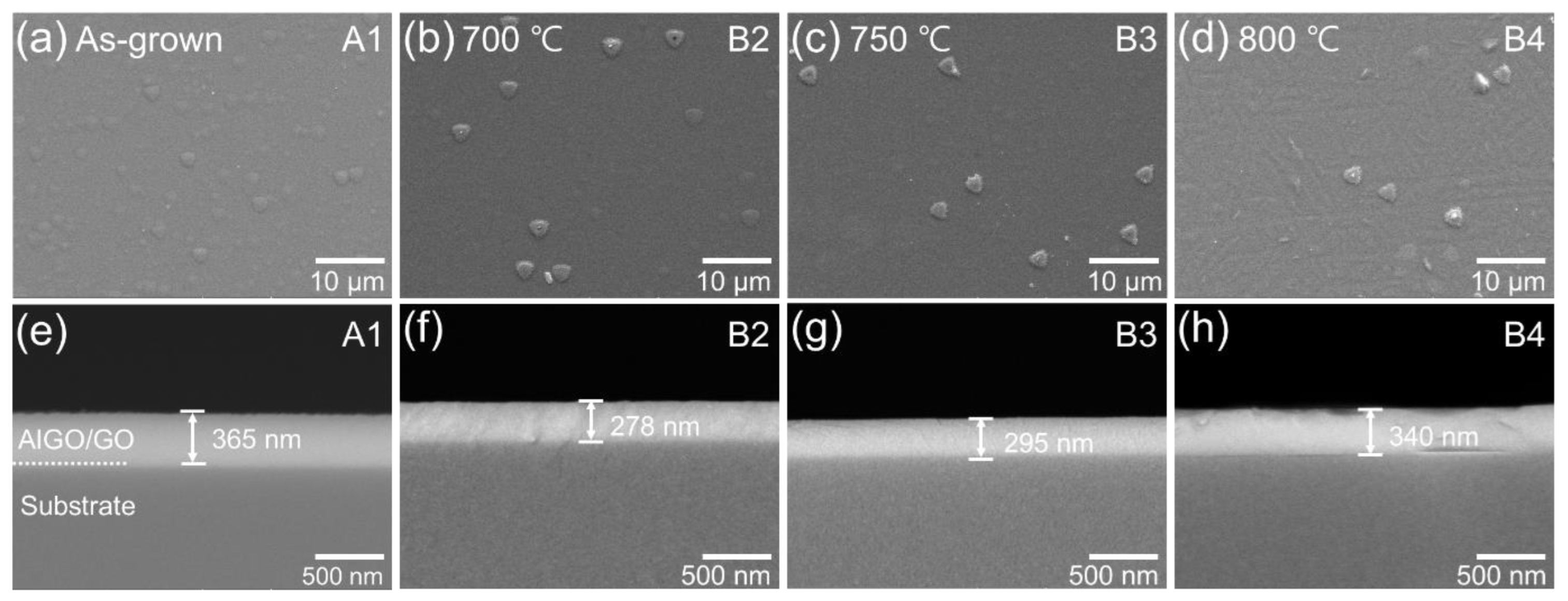
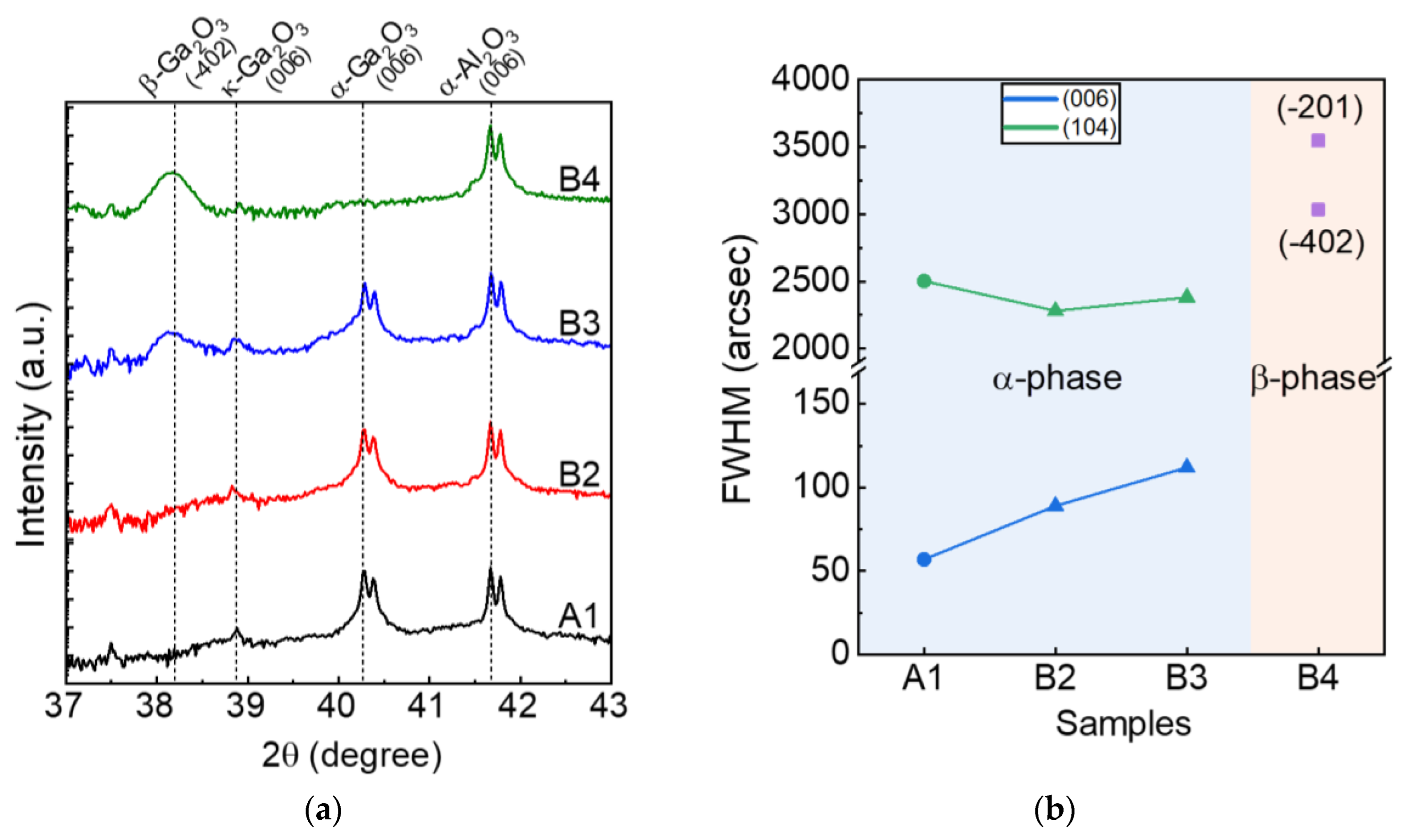
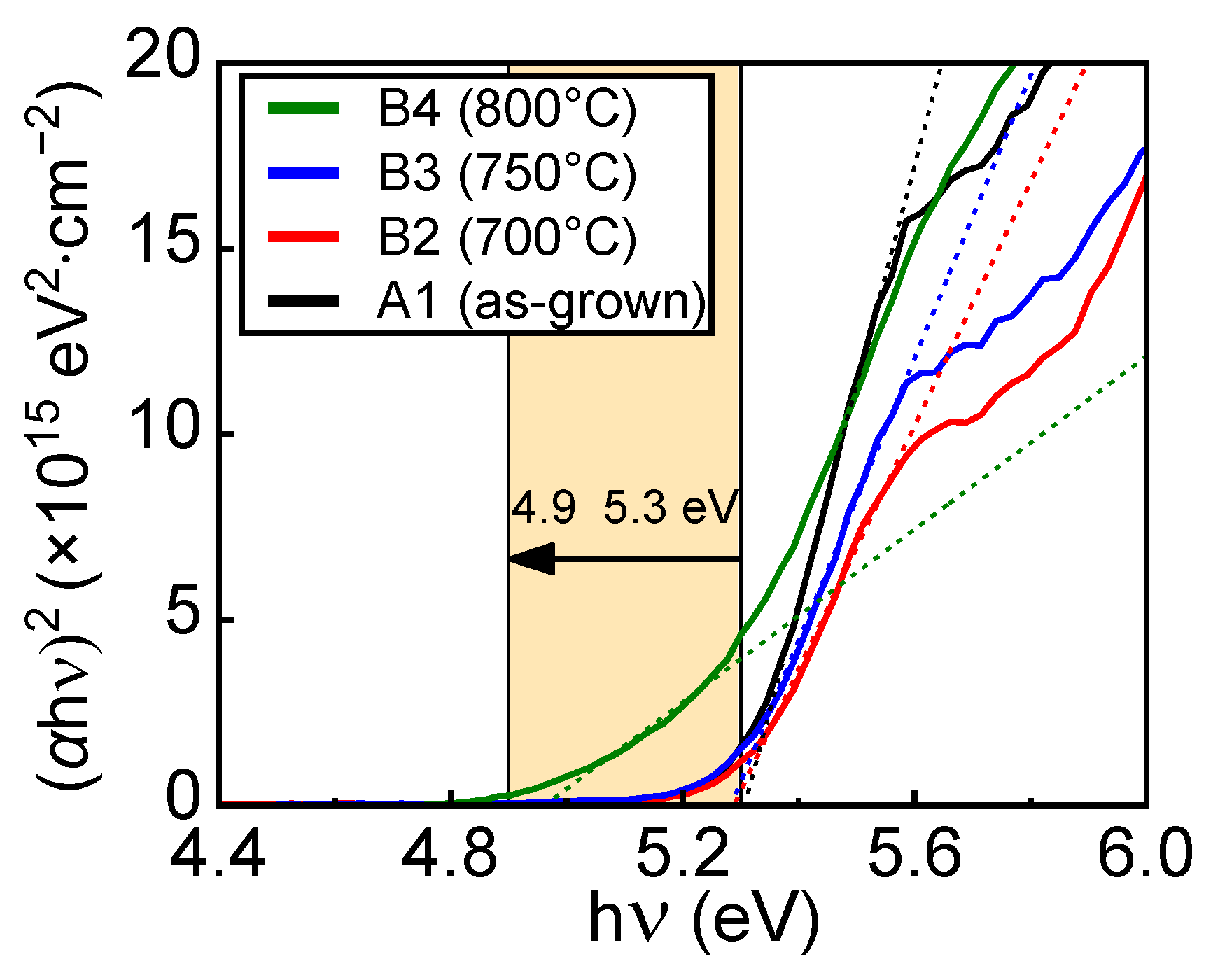
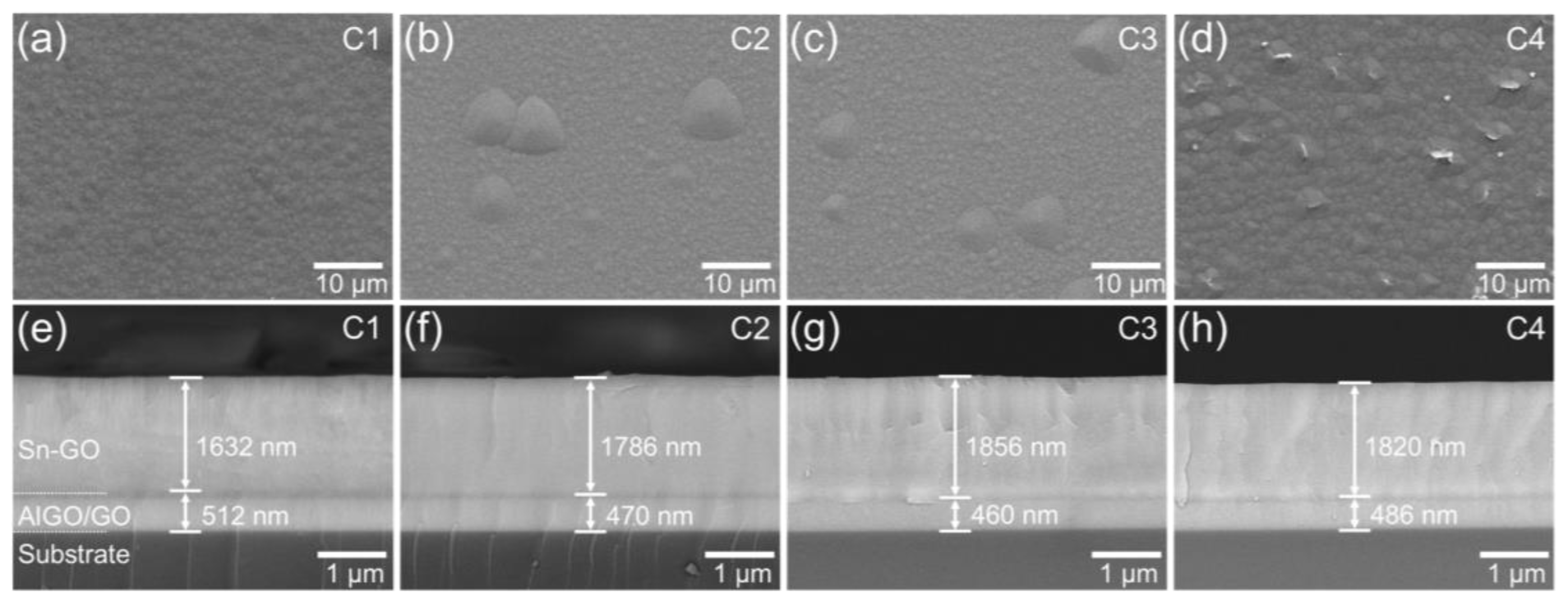
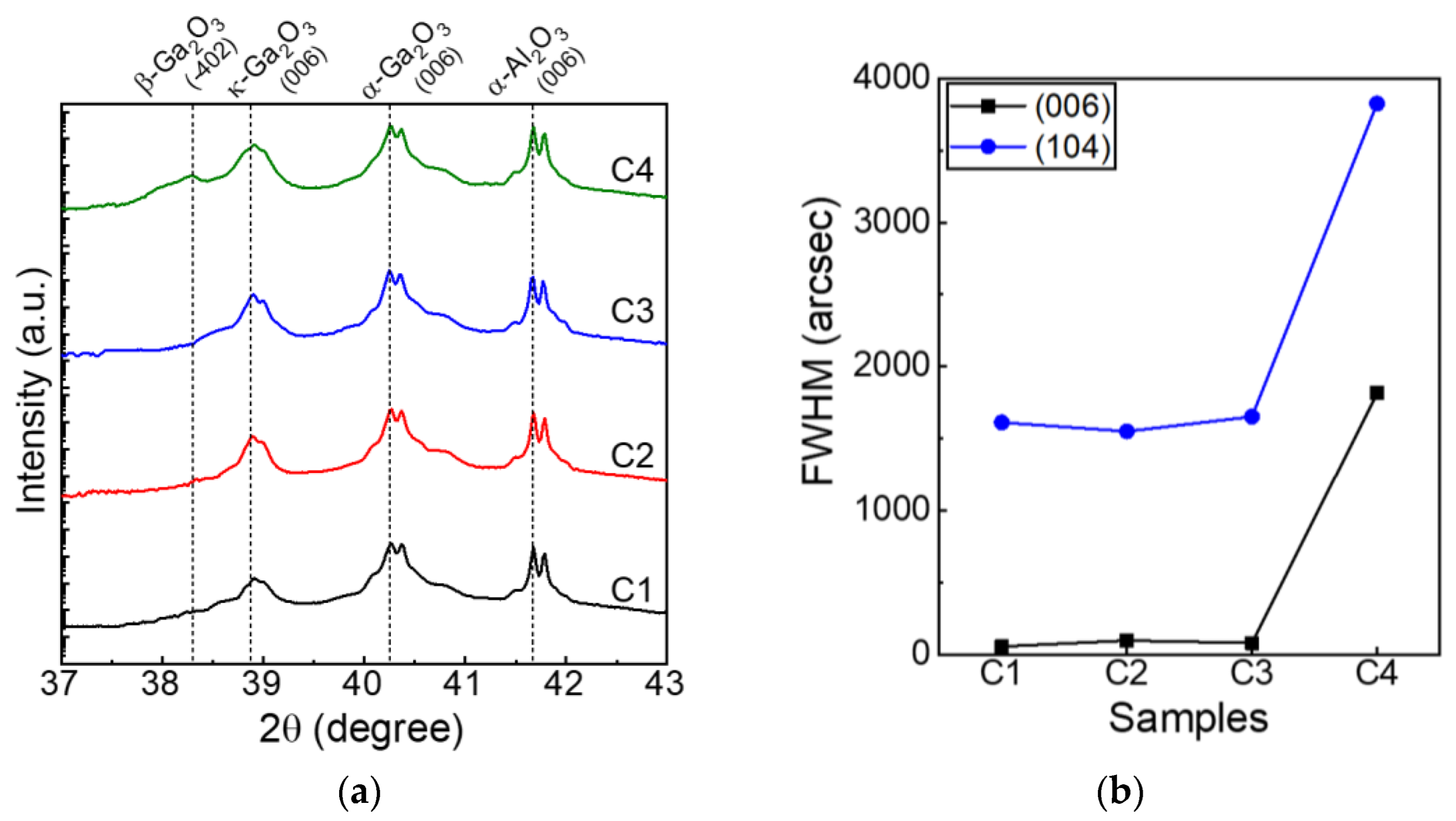

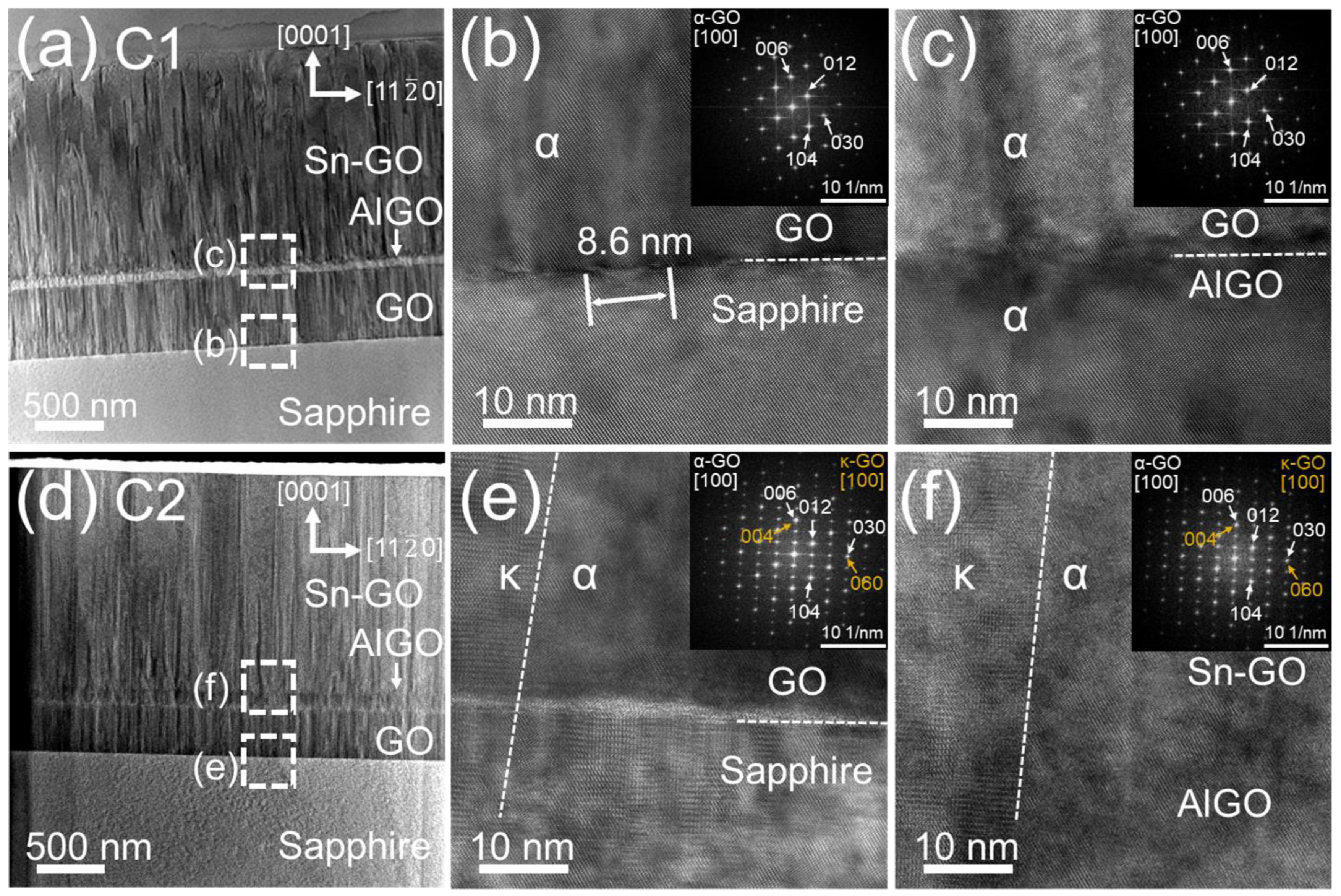
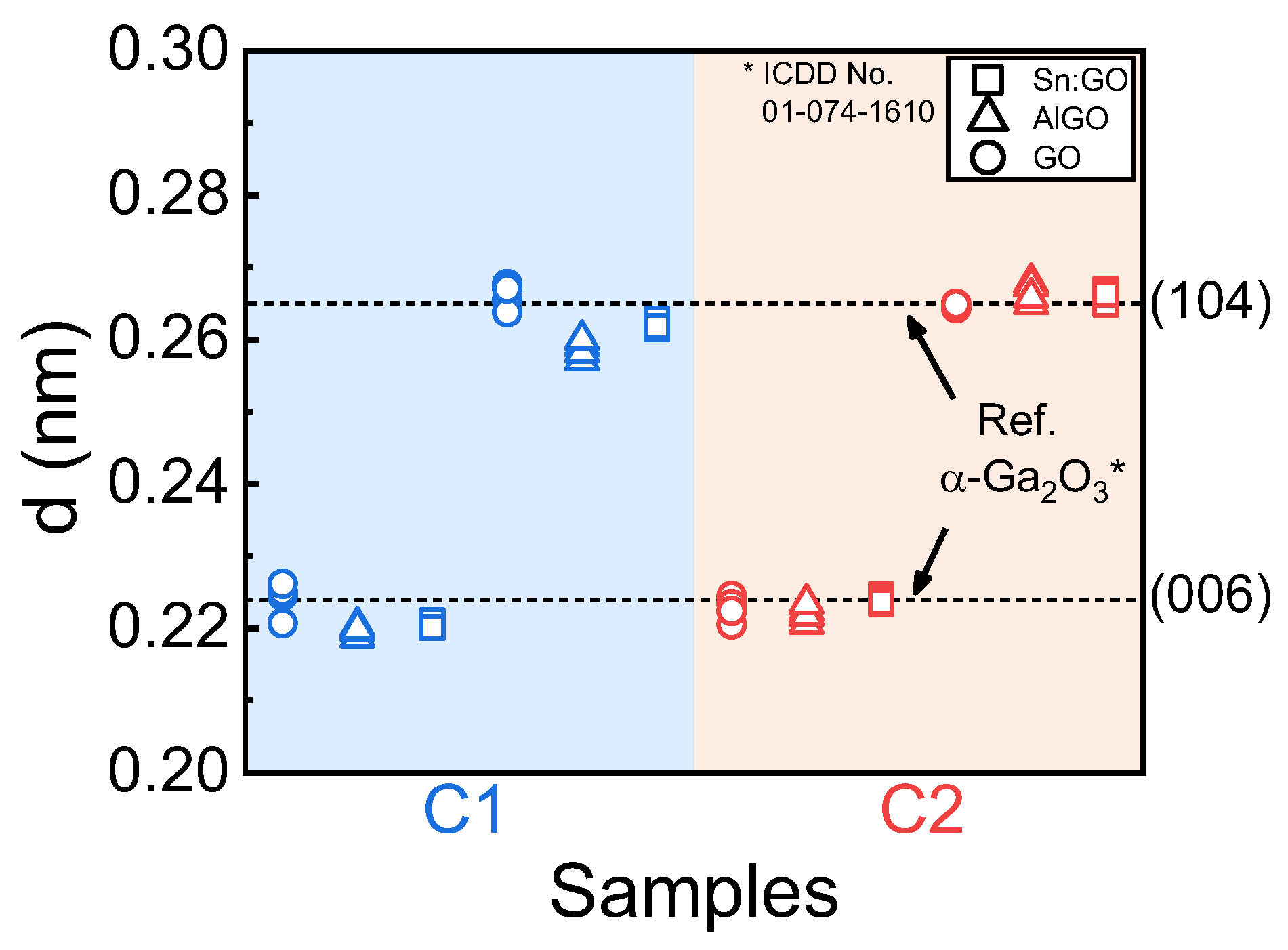
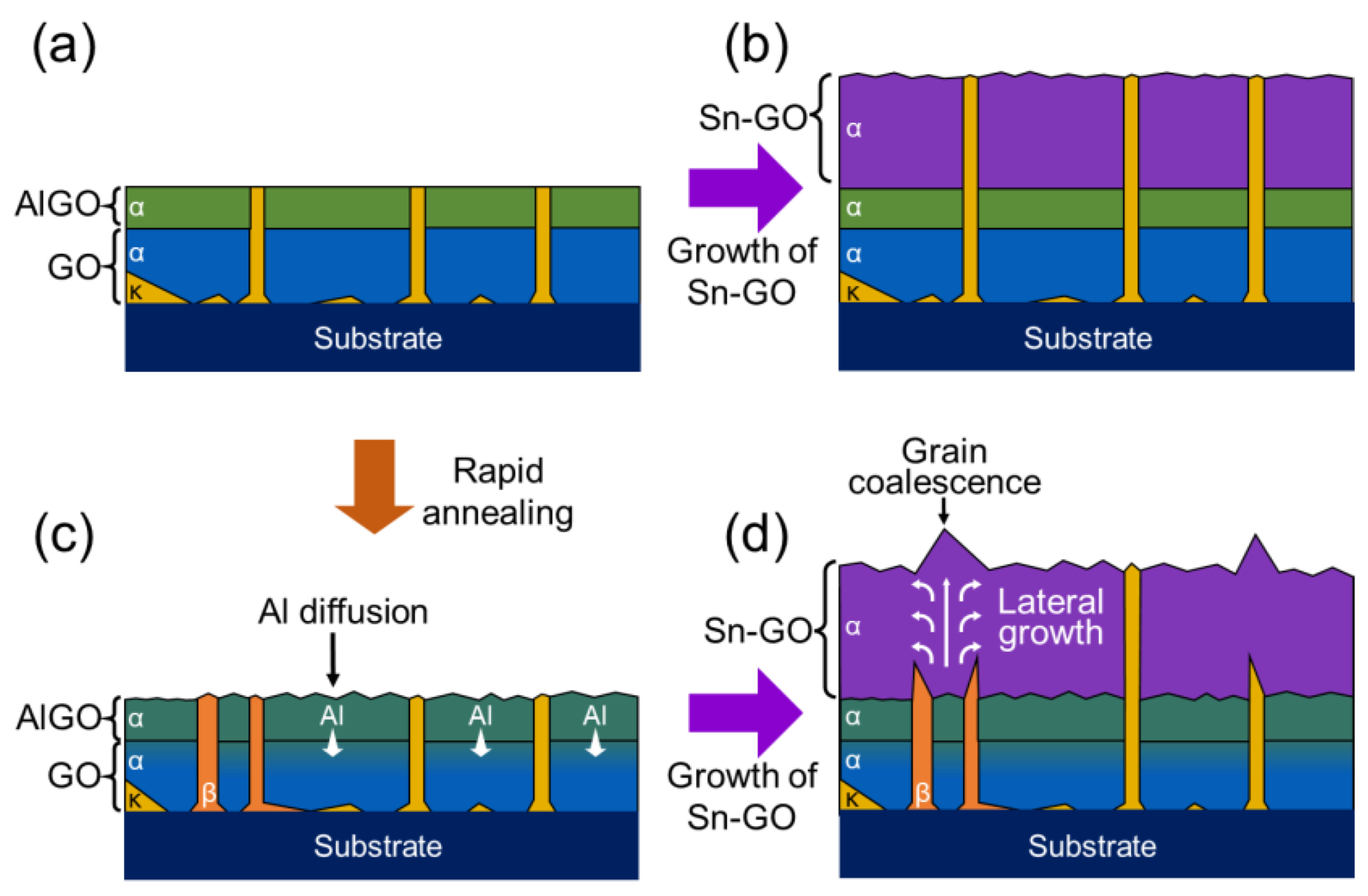
| Step | Step A | Step B | Step C | |||
|---|---|---|---|---|---|---|
| Sample | A1 | B2 | B3 | B4 | C1–C4 | |
| Process | Buffer growth | Heat-treat | Heat-treat | Heat-treat | Film Growth | |
| Template | c-sapphire | A1 | A1 | A1 | A1–B4 | |
| Temperature | 450/500 °C | 700 °C | 750 °C | 800 °C | 450 °C | |
| Process time | 1/2 h | 3 min | 3 min | 3 min | 3 h | |
| Precursor Conc. | Ga(acac)3 | 0.03 M/0.05 M | ||||
| Al(acac)3 | 0.18 M/— | |||||
| SnCl2 | 0.1 mol% | |||||
| Gas | Carrier (air) | 5 L/min | N2 | N2 | N2 | 5 L/min |
| Dilution (O2) | 5 L/min | 5 L/min | ||||
| Sample | Process | Carrier Concentration (cm−3) | Electron Mobility (cm2/V·s) |
|---|---|---|---|
| Ref. [19] | No buffer | 1.8 × 1018 | 3.8 |
| C1 | Buffers (no annealing) Buffers (annealing at 700 °C) Buffers (annealing at 750 °C) Buffers (annealing at 800 °C) | 1.6 × 1019 | 3.7 |
| C2 | 4.1 × 1018 | 21.1 | |
| C3 | 7.4 × 1018 | 13.0 | |
| C4 | — | — |
Disclaimer/Publisher’s Note: The statements, opinions and data contained in all publications are solely those of the individual author(s) and contributor(s) and not of MDPI and/or the editor(s). MDPI and/or the editor(s) disclaim responsibility for any injury to people or property resulting from any ideas, methods, instructions or products referred to in the content. |
© 2024 by the authors. Licensee MDPI, Basel, Switzerland. This article is an open access article distributed under the terms and conditions of the Creative Commons Attribution (CC BY) license (https://creativecommons.org/licenses/by/4.0/).
Share and Cite
Kim, K.-H.; Shin, Y.-J.; Jeong, S.-M.; Lee, H.; Bae, S.-Y. Controlled Crystallinity of a Sn-Doped α-Ga2O3 Epilayer Using Rapidly Annealed Double Buffer Layers. Nanomaterials 2024, 14, 178. https://doi.org/10.3390/nano14020178
Kim K-H, Shin Y-J, Jeong S-M, Lee H, Bae S-Y. Controlled Crystallinity of a Sn-Doped α-Ga2O3 Epilayer Using Rapidly Annealed Double Buffer Layers. Nanomaterials. 2024; 14(2):178. https://doi.org/10.3390/nano14020178
Chicago/Turabian StyleKim, Kyoung-Ho, Yun-Ji Shin, Seong-Min Jeong, Heesoo Lee, and Si-Young Bae. 2024. "Controlled Crystallinity of a Sn-Doped α-Ga2O3 Epilayer Using Rapidly Annealed Double Buffer Layers" Nanomaterials 14, no. 2: 178. https://doi.org/10.3390/nano14020178
APA StyleKim, K.-H., Shin, Y.-J., Jeong, S.-M., Lee, H., & Bae, S.-Y. (2024). Controlled Crystallinity of a Sn-Doped α-Ga2O3 Epilayer Using Rapidly Annealed Double Buffer Layers. Nanomaterials, 14(2), 178. https://doi.org/10.3390/nano14020178








